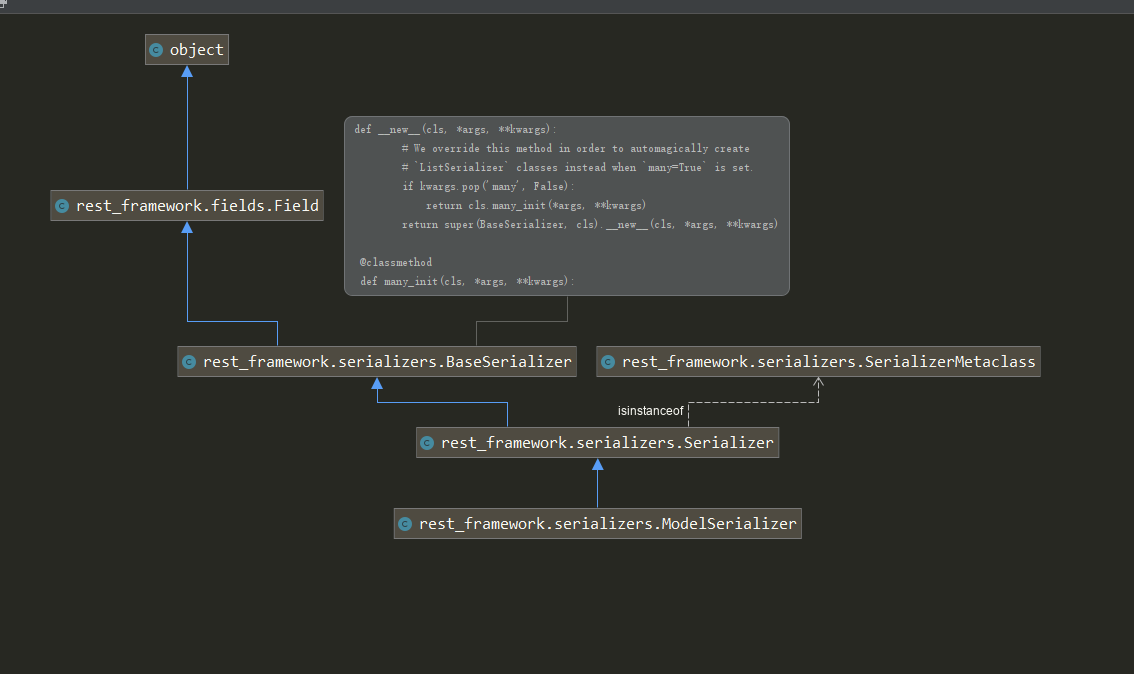Django Rest Framework-----序列化(serializers)
class PublishModelSerializers(serializers.ModelSerializer): class Meta: model=Publish fields="__all__"#book表的所有字段 ''' 不用按字段,直接序列化到表模型 #必须写一个内部内,名字必须交Meta''' class BookSerializers(serializers.Serializer): title = serializers.CharField(max_length=32) price = serializers.IntegerField() pub_date = serializers.DateField() publish=serializers.CharField(source="publish.name") ''' -1 重命名:用source:xx = serializers.CharField(source='name') -2 取出出版社名字: 方式一: -在模型表中重写__str__方法 -publish=serializers.CharField() 方式二: -用source -拿出出版社的城市 -publish=serializers.CharField(source='publish.city') *****如果不指定source,字段必须对应起来,如果指定了source,字段可以任意命名 -source 可以指定字段,也可也指定方法 publish.test这是个方法,会执行该方法,并拿到返回结果 test = serializers.CharField(source='publish.test') -3 SerializerMethodField,可以指定一个方法 publish=serializers.SerializerMethodField() # 方法名:叫get_字段名,要传参数,参数是:当前book对象 def get_publish(self,obj): # obj 是当前book对象 dic={'name':obj.publish.name,'email':obj.publish.email} return dic -方法内部可以继续用其他的序列化类 -ModelSerializer -必须在类中写 class Meta: model=指定表 # fields = '__all__' # 指定只取这两个字段 fields = ['nid','name'] # 去掉指定的字段 # exclude=['publish','authors'] # fields,跟exclude不能连用 # 指定深度,就是跨几个表(官方建议小于10,我给你的建议小于3) # depth = 2 Serializer小总结 ''' #authors=serializers.CharField(source="authors.all") authors = serializers.SerializerMethodField()
自定义字段名称,和数据模型不一致,需要指定source本质调用get_authors()方法获取数据
def get_authors(self,obj): temp=[] for obj in obj.authors.all(): temp.append(obj.name) return temp ''' 序列化BookSerializers(book_list,many=True)过程: temp=[] for obj in book_list: temp.append({ "title":obj.title, "price":obj.price, "pub_date":obj.pub_date, "publish":str(obj.publish), # obj.publish.name #"authors":obj.authors.all, "authors": get_authors(obj) }) ''' class BookModelSerializers(serializers.ModelSerializer): class Meta: model = Book fields = "__all__" # publish=serializers.CharField(source="publish.pk") publish=serializers.HyperlinkedIdentityField( view_name="detailpublish", lookup_field="publish_id", lookup_url_kwarg="pk" )
# #view_name,urls.py目标url的视图别名(name),这里是UserGroup的视图别名lookup_field 给url传递的参数,也就是正则匹配的字段lookup_url_kwarg,url中正则名称,也就是kwargs中的key

class BookDetailView(APIView): def get(self, request, id): book = Book.objects.filter(pk=id).first() bs = BookModelSerializers(book, context={'request': request})# instance接受queryset对象或者单个model对象,当有多条数据时候,使用many=True,单个对象many=False #若需生成超链接字段,则需要加context={'request': request} return Response(bs.data) def put(self, request, id): book = Book.objects.filter(pk=id).first() bs = BookModelSerializers(book, data=request.data) if bs.is_valid(): bs.save() return Response(bs.data) else: return Response(bs.errors) def delete(self, request, id): Book.objects.filter(pk=id).delete() return Response()
源码剖析

-
类是实例化之前会执行__new__方法,用于控制一个类生成实例的过程
- 子类没有__new__方法执行父类的__new__方法
- __new__方法执行完以后执行__init__构造方法
以ModelSerializer为例,无__new__方法,其父类Serializer也没有,在往上父类BaseSerializer中含有__new__方法,分析请看注释,下面是源码部分:
class BaseSerializer(Field): """ The BaseSerializer class provides a minimal class which may be used for writing custom serializer implementations. Note that we strongly restrict the ordering of operations/properties that may be used on the serializer in order to enforce correct usage. In particular, if a `data=` argument is passed then: .is_valid() - Available. .initial_data - Available. .validated_data - Only available after calling `is_valid()` .errors - Only available after calling `is_valid()` .data - Only available after calling `is_valid()` If a `data=` argument is not passed then: .is_valid() - Not available. .initial_data - Not available. .validated_data - Not available. .errors - Not available. .data - Available. """ def __init__(self, instance=None, data=empty, **kwargs): self.instance = instance if data is not empty: self.initial_data = data self.partial = kwargs.pop('partial', False) self._context = kwargs.pop('context', {}) kwargs.pop('many', None) super(BaseSerializer, self).__init__(**kwargs) def __new__(cls, *args, **kwargs): # We override this method in order to automagically create # `ListSerializer` classes instead when `many=True` is set. if kwargs.pop('many', False): return cls.many_init(*args, **kwargs) return super(BaseSerializer, cls).__new__(cls, *args, **kwargs)
执行玩__new__方法接着执行__init__构造方法,此时有根据many值不同执行不同的构造方法,当many=True时候执行cls.many_init方法,
@classmethod def many_init(cls, *args, **kwargs): """ This method implements the creation of a `ListSerializer` parent class when `many=True` is used. You can customize it if you need to control which keyword arguments are passed to the parent, and which are passed to the child. Note that we're over-cautious in passing most arguments to both parent and child classes in order to try to cover the general case. If you're overriding this method you'll probably want something much simpler, eg: @classmethod def many_init(cls, *args, **kwargs): kwargs['child'] = cls() return CustomListSerializer(*args, **kwargs) """ allow_empty = kwargs.pop('allow_empty', None) child_serializer = cls(*args, **kwargs) list_kwargs = { 'child': child_serializer, } if allow_empty is not None: list_kwargs['allow_empty'] = allow_empty list_kwargs.update({ key: value for key, value in kwargs.items() if key in LIST_SERIALIZER_KWARGS }) meta = getattr(cls, 'Meta', None) list_serializer_class = getattr(meta, 'list_serializer_class', ListSerializer) return list_serializer_class(*args, **list_kwargs) # 最后使用ListSerializer进行实例化
从上面源码中我们知道,对于单独的对象,采用的是Serializer类进行处理,若对象是QuerySet类型(多个对象列表),采用LIstSeriallizer处理,此时我们调用对象的data属性获取结果(示例中这使用的是res.data),下面是源码(寻找时候先从子类找,无该属性就去父类找):

@property def data(self): ret = super(Serializer, self).data# 执行父类data属性
return ReturnDict(ret, serializer=self)
父类BaseSerialize的属性方法data源码:
@property def data(self): if hasattr(self, 'initial_data') and not hasattr(self, '_validated_data'):#校验数据时使用
msg = ( 'When a serializer is passed a `data` keyword argument you ' 'must call `.is_valid()` before attempting to access the ' 'serialized `.data` representation.\n' 'You should either call `.is_valid()` first, ' 'or access `.initial_data` instead.' ) raise AssertionError(msg) if not hasattr(self, '_data'): if self.instance is not None and not getattr(self, '_errors', None):#判断有误错误,无错误进行序列化 self._data = self.to_representation(self.instance)# 将instance(QuerySet对象)传入,开始序列化
elif hasattr(self, '_validated_data') and not getattr(self, '_errors', None): self._data = self.to_representation(self.validated_data) else: self._data = self.get_initial() return self._data
从以上源码中可以看出,序列化方法是通过调用类的self.to_representation方法进行序列化,下面我们看Serializer类的to_representation方法
def to_representation(self, instance): """ Object instance -> Dict of primitive datatypes. """ ret = OrderedDict() #先将instance转化为有序字典 fields = self._readable_fields for field in fields: # 循环定义的字段,这个字段可以是我们自己定义的,也可以是model中的字段 try: attribute = field.get_attribute(instance) #调用字段的get_attribute方法(参数是对象),在示例中可以理解为group.get_attribute(group_obj), except SkipField: continue # We skip `to_representation` for `None` values so that fields do # not have to explicitly deal with that case. # # For related fields with `use_pk_only_optimization` we need to # resolve the pk value. check_for_none = attribute.pk if isinstance(attribute, PKOnlyObject) else attribute if check_for_none is None: ret[field.field_name] = None else: ret[field.field_name] = field.to_representation(attribute) return ret
以上源码中,调用field.get_attribute(instance)方法获取每个字段的数据,下面是field.get_attribute(instance)源码(在Field中)
def get_attribute(self, instance): """ Given the *outgoing* object instance, return the primitive value that should be used for this field. """ try: return get_attribute(instance, self.source_attrs) # 执行get_attribute函数,用于根据定义的字段属性,获取不同的数据,注意该方法没有带self,是一个函数,并不是类方法。 self.source_attrs:以'.'分割的列表,会被使用为反射获取属性 except (KeyError, AttributeError) as exc: if self.default is not empty: return self.get_default() if self.allow_null: return None if not self.required: raise SkipField() msg = ( 'Got {exc_type} when attempting to get a value for field ' '`{field}` on serializer `{serializer}`.\nThe serializer ' 'field might be named incorrectly and not match ' 'any attribute or key on the `{instance}` instance.\n' 'Original exception text was: {exc}.'.format( exc_type=type(exc).__name__, field=self.field_name, serializer=self.parent.__class__.__name__, instance=instance.__class__.__name__, exc=exc ) ) raise type(exc)(msg)
调用get_attribute函数,进一步出来,需要分析self.source_attrs参数,下面是self.source_attrs部分源码:
if self.source == '*': self.source_attrs = [] else: self.source_attrs = self.source.split('.') #self.source是我们自定义字段传入的source参数,如:gp=serializers.CharField(source='group.name'),sss=serializers.CharField(source='get_user_type_display') 最后分割变成['group','name']
以上分析self.source_attrs是一个列表(由source参数按点分割而来),继续回到get_attribute函数,下面是其源码:
def get_attribute(instance, attrs): """ Similar to Python's built in `getattr(instance, attr)`, but takes a list of nested attributes, instead of a single attribute. Also accepts either attribute lookup on objects or dictionary lookups. """ # attrs:['group','name']或者['get_user_type_display',] for attr in attrs: # 循环列表 try: if isinstance(instance, collections.Mapping): #若果是model字段映射(DRF的内部字段转化),直接调用model类的 instance = instance[attr]#重新赋值,此时的instance已经改变 else: instance = getattr(instance, attr) #否则,使用反射获取结果,如instance=getattr(userinfo_obj,group) except ObjectDoesNotExist: return None if is_simple_callable(instance): #判断是否是可执行,此时如我们示例中的get_user_type_display,其判断过程在类似下面TIPS中,这里不再做过多说明 try: instance = instance() #重新赋值,加括号进行执行 except (AttributeError, KeyError) as exc: # If we raised an Attribute or KeyError here it'd get treated # as an omitted field in `Field.get_attribute()`. Instead we # raise a ValueError to ensure the exception is not masked. raise ValueError('Exception raised in callable attribute "{0}"; original exception was: {1}'.format(attr, exc)) return instance
从上面的源码分析来看,序列化本质是使用了django的orm的QuerSet或者单个model对象特性,利用反射或者方法进行序列化。




